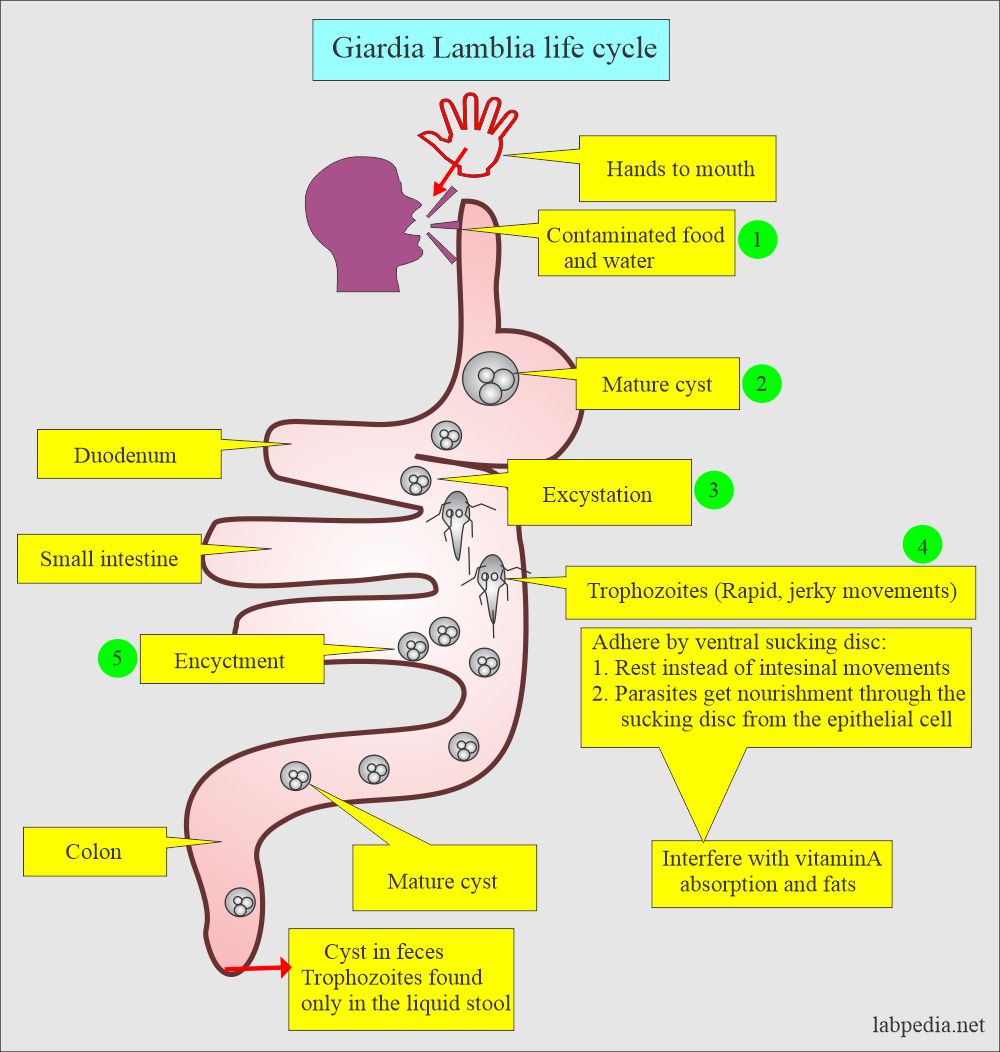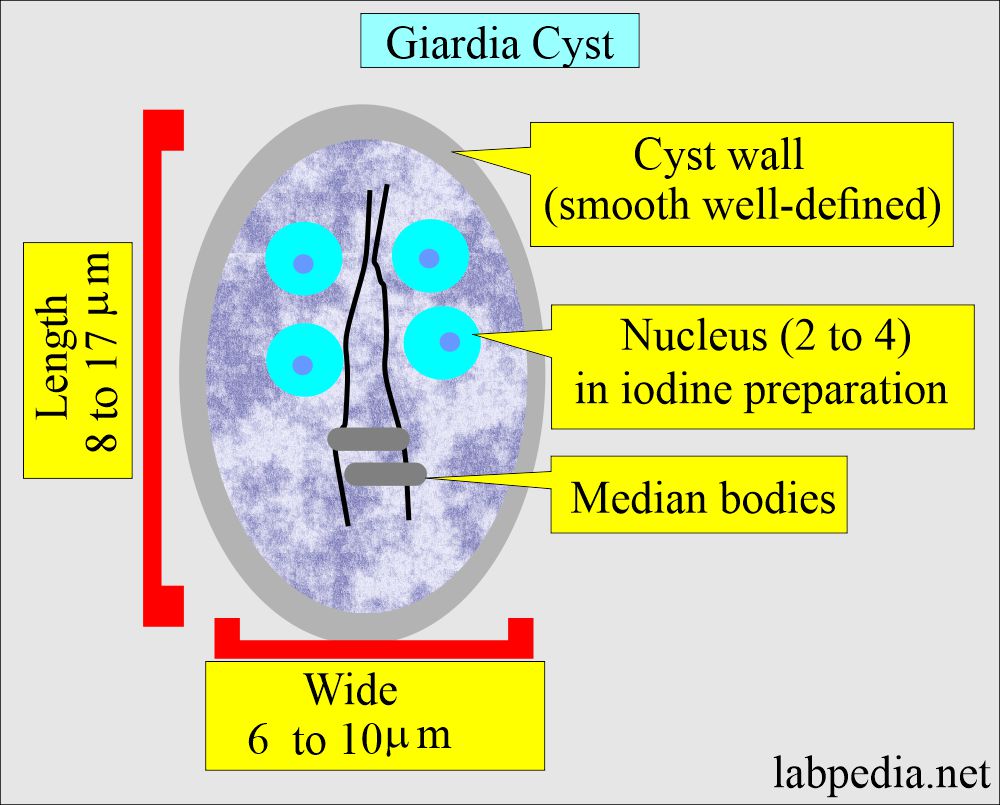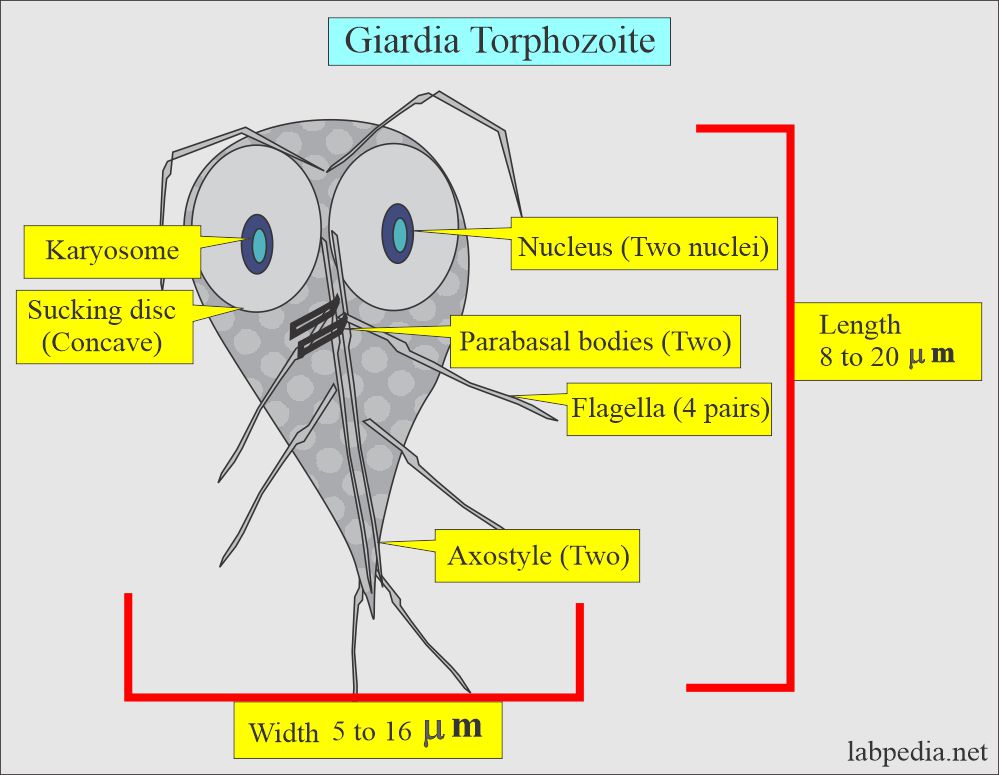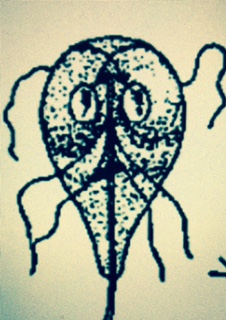Giardia Lamblia, Life Cycle and Diagnosis
Giardia Lamblia
What sample is needed for Giardia Lamblia?
- Make a saline wet smear from the loose stool.
- Make a smear from the duodenal contents.
- Make formalin-ethyl acetate concentrate of formed stool. Stain it with iodine.
- Giardia lamblia (Giardia duodenalis) causes Giardiasis or Lambliasis.
How will you define Giardia Lamblia?
- It is a flagellated protozoan and an important cause of diarrhea worldwide.
- This protozoan lives in the duodenum and proximal jejunum.
- This is the most common parasite in the USA.
Discuss history of Giardia Lamblia?
- Giardia lamblia was discovered in 1681 by Anton van Leeuwenhoek on examination of his stool.
- Secretary Robert Hooke wrote the first description of giardia of the Royal Society of London.
- Alfred Giard studied the flagellate from 1879 to 1881 and gave the name Giardia.
- Giardia trophozoites resemble the older man with mustaches and eyes.
- Some referred to them as looking like a monkey’s face.
What is the epidemiology of Giardia Lamblia?
- This disease is present throughout the world (Cosmopolitan).
- This disease is more common in children from 6 to 10 years.
- Giardia is highly infectious through contaminated foods and water.
- These cysts may spread through contaminated fruits and vegetables.
- These cysts are resistant to routine chlorination.
- Such water needs filtration and chemical treatment.
- Giardia may be sexually transmitted through oro-anal sex.
- This may spread through the water rodents.
- The groups at high risk are:
- Children in the daycare facility.
- People are living with poor sanitation.
- Travelers are traveling to endemic areas.
- People who are engaged in homosexual practice.
- In summary:
- It spreads through contaminated foods and water, sewage, flies, or food handlers and by hand to mouth.
- Man is the natural host.
- More common in children 6 to 10 years of age.
- Rats may get a temporary infection.
- There are outbreaks due to water-borne infections.
- Cysts are demonstrated in water in some outbreaks.
How will you classify Giardia Lamblia?
- This flagellate parasite belongs to:
- Subphylum Mastigophora.
- The class is Zoomastigophora.
- This spread through the oral-fecal route.
- Diseases are spread by infected water and foods.
How will you describe a summary of the life cycle of Giardia lamblia:
Discuss the mature cyst of Giardia Lamblia?
- It is ingested, passes through the stomach, and enters the small intestine.
- In the stomach, acid stimulates the cyst to excyst in the duodenum.
- The mature cyst has 4 nuclei.
- The size varies from 8 to 17 μm long and 6 to 10 μm wide.
- The cyst is colorless and smooth; it is distinct from the interior.
- The immature cyst has two nuclei and two median bodies.
- Nuclei are seen in the iodine preparation or with a permanent stain.
- In the duodenum, excystation takes place.
- This cyst releases the trophozoites, which mostly live in the small intestine.
- These trophozoites multiply roughly every 8 hours.
- In the small intestine, because of their sucking disc, they resist migration to the large intestine.
- They feed them by the suckling disc.
- They multiply in the small intestine.
- Trophozoites may enter the common bile duct and the gallbladder.
- This cyst releases the trophozoites, which mostly live in the small intestine.
- Then, entrapped trophozoites enter the colon. Here, encystment occurs.
How will you describe the trophozoites of Giardia Lamblia?
- It measures 8 to 12 μm in length and 5 to 16 μm in width.
- These are pear or teardrop in shape.
- Anteriorly, it is broad and round.
- Posteriorly, it is tapering.
- The dorsal surface is convex.
- It is a central karyosome.
- There are two axostyles.
- These have falling leaf movements.
- There are two ovoid nuclei.
- These are symmetrical and best seen on the stained smear.
- There are four pairs of flagella.
- There are two median bodies.
- There is encystation because of the unfavorable atmosphere in the large intestine.
- Now, these cysts are released into the stool.
- The cysts are released in the feces, which can survive 3 months in the water.
- The trophozoites cannot survive outside and soon die.
Discuss the pathogenesis of the disease caused by Giardia Lamblia?
- The attachment of the parasites to intestinal epithelial cells produces low-grade catarrhal inflammation.
- Mechanical and the action of the toxin interfere with the absorption of vitamin A and fats.
- There is weight loss.
- Cysts pass unharmed through the stomach juice.
- Excystation occurs in the duodenum.
- There was a study on the volunteers.
- Ingestion of 100 or more cysts leads to infection in all the volunteers.
- 10 to 25 cysts will infect 1/3 of the volunteers.
- 1 cyst will not cause infection.
- Chlorination will not kill the parasite, but iodine can.
How will you discuss the clinical Presentation of Giardia Lamblia?
- The patient may be asymptomatic.
- The incubation period is 1 to 3 weeks when the patient develops signs and symptoms.
- The patient may have mild to severe diarrhea with light-colored, fatty stool.
- This patient may have watery and occasionally foul-smelling diarrhea.
- This is due to irritation by the trophozoites.
- The stool is light-colored.
- The stool may be soft and greasy.
- There may be abdominal pain, cramps, flatulence, and epigastric tenderness.
- There is more gas and flatulence in these patients.
- This patient may develop abdominal cramps and bloat.
- There is nausea.
- There may be an epigastric tenderness.
- The patient may have anorexia.
- In severe cases, steatorrhea is not uncommon and may lead to a picture of malabsorption syndrome.
- Symptoms may be lost in 3 to 4 days or 1 to 3 weeks or may become chronic.
How will you discuss the Traveler’s diarrhea?
- Mild diarrhea, abdominal cramps, and anorexia characterize it.
- There may be weight loss.
- Ultimately, there is a typical picture of malabsorption syndrome.
- These symptoms may last for 2 to 6 weeks and, in some, last longer.
What are the Complications of Giardia Lamblia (Giardiasis)?
- There may be a deficiency of fat-soluble vitamins.
- There may be a deficiency of folic acid.
- There is hypoproteinemia.
- There may be hypogammaglobulinemia.
- There are structural changes in the intestinal villi.
how will you make the laboratory Diagnosis of Giardia Lamblia?
- Stool examination: Multiple samples are tested to rule out giardiasis.
- By this method, positivity is 50% to 70%.
- Three samples are enough, and each sample at a 2-day interval is sufficient.
- When you check multiple slides, the first sample detects 75% of the cases.
- Make a direct wet or saline smear from the stool and look for Giardia.
- Trophozoites:
- The unstained smear shows the trophozoites with progressive falling leaf motility.
- It is pear-shaped with a posterior end.
- This unstained smear is suggestive of Giardia.
- In duodenal aspirate or biopsy, you may see trophozoites.
- A stained smear is diagnostic and shows all parts of trophozoites.
- Nuclei are seen in the area of the sucking disc.
- Parabasal bodies are seen posterior to the sucking disc.
- There is a typical arrangement of axonemes.
- Cysts: These measure 8 to 14 μm by 7 to 10 μm.
- Giardia cysts may pass at 1, 2, 3, or even 7 to 8 days intervals.
- Unstained cysts are suggestive of Giardia.
- This is oval in shape.
- There are refractile threads in the cytoplasm.
- Cyst-stained is diagnostic.
- There are four nuclei.
- There are four median bodies.
- There are numerous axonemes.
- Duodenal aspiration of the biopsy may be done to diagnose it.
- Duodenal aspirated material detects 80% of the cases, more than stool positivity.
- Serological test:
- Direct fluorescent antibody test.
- Detection of Giardia antigen by EIA has more sensitivity than stool examination.
- Summary of the diagnosis:
- Identification of the cysts or trophozoites in the stool.
- Trophozoites can be found in the duodenal aspirate or biopsy.
How will you treat Giardia Lamblia?
- The most commonly used drug is Metronidazole (Flagyl). 250 mg tablets three times a day for 5 days.
- Young children’s total daily dose is:
- For those under 2 years of age, it is 125 mg.
- 2 to 4 years of age 250 mg.
- 4 to 8 years of age is 375 mg.
- 8 to 12 years of age is 500 mg.
- Young children’s total daily dose is:
- Albendazole 400 mg daily for 5 days.
- Mebendazole 200 mg three times a day for 5 days.
- Another used drug is Tinidazole (Tindamax), which is a single dose.
- Nitazoxanide (Alinia) is liquid and easy for children to swallow.
How you can Control of the Giardiasis (Prevention)?
- Prevent fecal-contaminated water and foods.
- Safe sex.
- Portable purification unit for travelers.
- Educate the public on the transmission of the disease and methods to protect it.
- The double strength of iodine is needed to kill the giardia.
Questions and answers:
Question 1: How many samples are taken to diagnose G. Lamblia?
Question 2: Who diagnosed the giardia lamblia?







I am delighted that I discovered this weblog, exactly the right information that I was looking for! .
Thanks for the wonderful remarks.
Useful
Amazing web
Thanks.
Thanks
Thank you for this educative information.
Stay blessed Sir .🙏
Thanks for your comment.